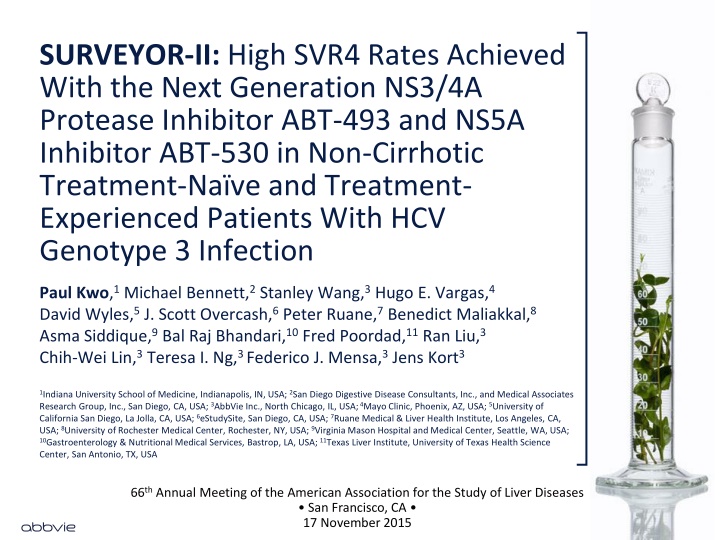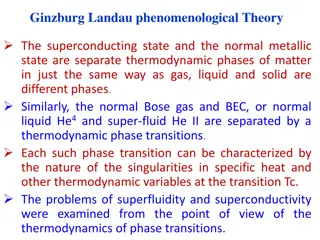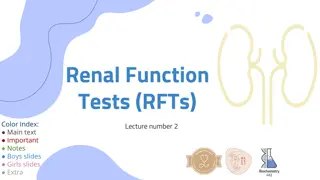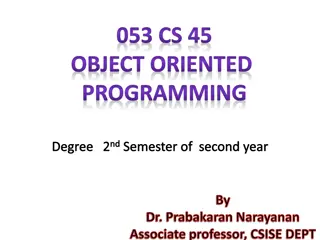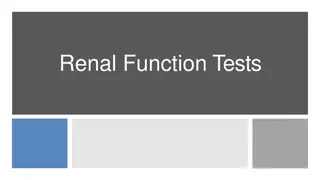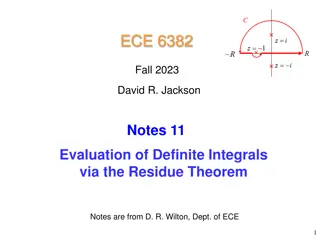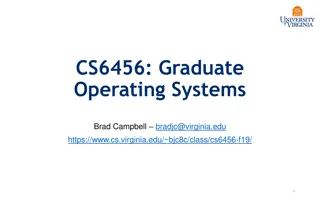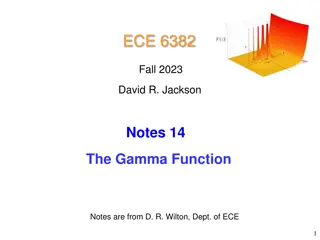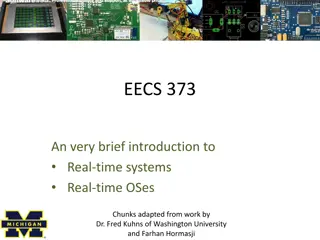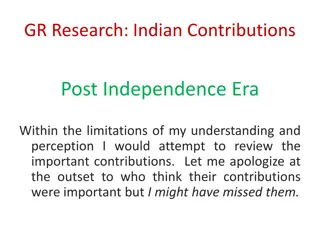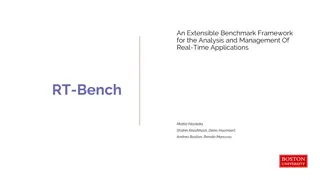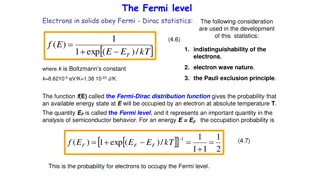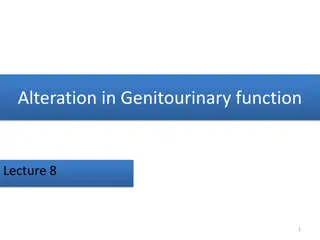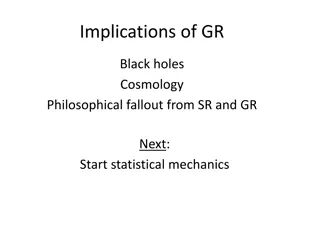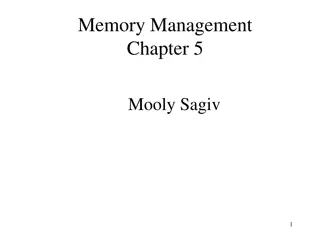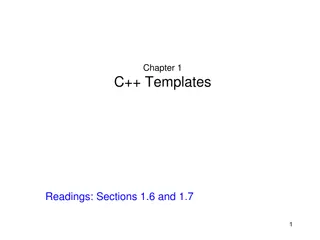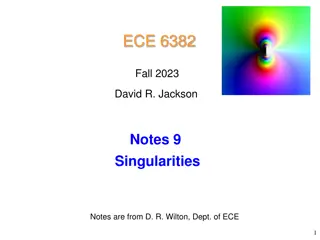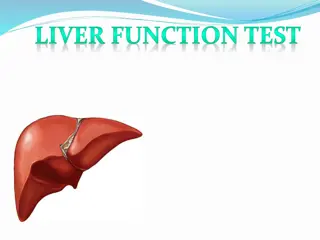Analyzing Discriminants of Real Function Singularities
Dive into the intriguing world of discriminants for real function singularities at a seminar in Real and Complex Geometry at Tel-Aviv University. Explore the concept of discriminants, examples like semicubic parabola and swallowtail, and how they separate parameter spaces into distinct domains. Understand the implications of discriminants in PDE theory, integral geometry, and projective duality. Uncover the significance of versal deformations and rigid equivalence in Real Algebraic Geometry, shedding light on a fascinating classification approach.
Download Presentation

Please find below an Image/Link to download the presentation.
The content on the website is provided AS IS for your information and personal use only. It may not be sold, licensed, or shared on other websites without obtaining consent from the author.If you encounter any issues during the download, it is possible that the publisher has removed the file from their server.
You are allowed to download the files provided on this website for personal or commercial use, subject to the condition that they are used lawfully. All files are the property of their respective owners.
The content on the website is provided AS IS for your information and personal use only. It may not be sold, licensed, or shared on other websites without obtaining consent from the author.
E N D
Presentation Transcript
SURVEYOR-II: High SVR4 Rates Achieved With the Next Generation NS3/4A Protease Inhibitor ABT-493 and NS5A Inhibitor ABT-530 in Non-Cirrhotic Treatment-Na ve and Treatment- Experienced Patients With HCV Genotype 3 Infection Paul Kwo,1Michael Bennett,2Stanley Wang,3Hugo E. Vargas,4 David Wyles,5J. Scott Overcash,6Peter Ruane,7Benedict Maliakkal,8 Asma Siddique,9Bal Raj Bhandari,10Fred Poordad,11Ran Liu,3 Chih-Wei Lin,3Teresa I. Ng,3 Federico J. Mensa,3Jens Kort3 1Indiana University School of Medicine, Indianapolis, IN, USA; 2San Diego Digestive Disease Consultants, Inc., and Medical Associates Research Group, Inc., San Diego, CA, USA; 3AbbVie Inc., North Chicago, IL, USA; 4Mayo Clinic, Phoenix, AZ, USA; 5University of California San Diego, La Jolla, CA, USA; 6eStudySite, San Diego, CA, USA; 7Ruane Medical & Liver Health Institute, Los Angeles, CA, USA; 8University of Rochester Medical Center, Rochester, NY, USA; 9Virginia Mason Hospital and Medical Center, Seattle, WA, USA; 10Gastroenterology & Nutritional Medical Services, Bastrop, LA, USA; 11Texas Liver Institute, University of Texas Health Science Center, San Antonio, TX, USA 66th Annual Meeting of the American Association for the Study of Liver Diseases San Francisco, CA 17 November 2015 1
Disclosures P Kwo: Grant/research support: AbbVie, BMS, Gilead, Janssen, Merck; Advisor: AbbVie, BMS, Gilead, Janssen, Merck. M Bennett: Stockholder: AbbVie; Clinical trial investigator: AbbVie. HE Vargas: Grant/research support: AbbVie, BMS, Gilead, Merck. D Wyles: Grant/research support: AbbVie, BMS, Gilead, Merck, Tacere Therapeutics; Consultant/Advisor: AbbVie, BMS, Gilead, Janssen, Merck. JS Overcash: No relevant conflicts to disclose. P Ruane: Grant/research Support: AbbVie, BMS, Gilead, Merck, ViiV, Janssen; Consultant/Advisor: AbbVie, Merck, Gilead, Jannsen: Speaker: Gilead, ViiV, Merck, Janssen. B Maliakkal: Speaker: AbbVie, Gilead, BMS. A Siddique: No relevant conflicts to disclose. B Bhandari: No relevant conflicts to disclose. F Poordad: Grant/research support: Abbvie, Achillion Pharmaceuticals, Anadys Pharmaceuticals, Biolex Therapeutics, Boehringer Ingelheim, Bristol-Myers Squibb, Genentech, Gilead Sciences, GlaxoSmithKline, GlobeImmune, Idenix Pharmaceuticals, Idera Pharmaceuticals, Intercept Pharmaceuticals, Janssen, Medarex, Medtronic, Merck, Novartis, Santaris Pharmaceuticals, Scynexis Pharmaceuticals, Vertex Pharmaceuticals, ZymoGenetics. Speaker: Gilead, Kadmon, Merck, Onyx/Bayer, Genentech, GlaxoSmithKline, Salix, Vertex. Consultant/Advisor: AbbVie, Achillion Pharmaceuticals, Anadys Pharmaceuticals, Biolex Therapeutics, Boehringer Ingelheim, Bristol-Myers Squibb, Gilead Sciences, GlaxoSmithKline, GlobeImmune, Idenix, Merck, Novartis, Tibotec/Janssen, Theravance, Vertex. S Wang, R Liu, CW Lin, TI Ng, F Mensa, J Kort: AbbVie employees and may hold AbbVie stock or stock options. The design, study conduct, analysis, and financial support of the SURVEYOR-II (NCT02243293) study were provided by AbbVie. AbbVie participated in the interpretation of data, review, and approval of the content. All authors had access to all relevant data and participated in writing, review, and approval of this presentation. Medical writing support was provided by Sharanya Ford, PhD, of AbbVie. This presentation contains information on the investigational products ABT-493 and ABT-530. SURVEYOR-II: ABT-493 and ABT-530 for HCV Genotype 3 Infection | AASLD | 17 November 2015 2
Hepatitis C Virus (HCV) Genotype 3 Infection Associated with higher rates of liver steatosis and an increased risk for hepatocellular carcinoma and fibrosis progression when compared with other HCV genotypes1 Accounts for 8 13% of all cases in the United States2 Accounts for approximately 30% of HCV infections worldwide and is now considered the most difficult-to-cure genotype3 1. 2. 3. Andriulli A, et al. Aliment Pharmacol Ther. 2008; 28:397-404. Kohli A, et al. JAMA. 2014; 312:631-640. Messina JP, et al. Hepatology. 2015; 61:77-87. SURVEYOR-II: ABT-493 and ABT-530 for HCV Genotype 3 Infection | AASLD | 17 November 2015 3
Next Generation Direct-Acting Antivirals ABT-493: pangenotypic HCV NS3/4A protease inhibitor* (GT3 EC50 1.6 nM) ABT-530: pangenotypic HCV NS5A inhibitor (GT3 EC50 2 pM) In vitro characteristics:1,2 Higher barrier to resistance Activity against common variants (eg, GT3 NS5A: M28T or Y93H) Additive/synergistic antiviral activity Clinical pharmacokinetics and metabolism: Once-daily oral dosing Minimal metabolism and primary biliary excretion No renal excretion (<1%) *ABT-493 identified by AbbVie and Enanta. 1. 2. Ng TI, et al. Abstract 636. 21st Conference on Retroviruses and Opportunistic Infections., Boston, 2014. Ng TI, et al. Abstract 639. 21st Conference on Retroviruses and Opportunistic Infections., Boston, 2014. SURVEYOR-II: ABT-493 and ABT-530 for HCV Genotype 3 Infection | AASLD | 17 November 2015 4
SURVEYOR-II Part 1 (GT3): Study Design SURVEYOR-II is an open-label, multicenter phase 2 trial evaluating the safety and efficacy of co-administered ABT-493 and ABT-530, at varying doses, ribavirin (RBV), in patients with HCV GT2 or GT3 infection Day 1 PT Week 24 Week 12 Treatment period Post-treatment (PT) period ABT-493 300 mg + ABT-530 120 mg n=30 ABT-493 200 mg + ABT-530 120 mg n=30a ABT-493 200 mg + ABT-530 120 mg + RBVb n=31 ABT-493 200 mg + ABT-530 40 mg n=30 ClinicalTrials.gov: NCT02243293. N=121. aIncludes one patient who was incorrectly assigned to treatment in the GT2 cohort. bDaily dose of 1000 mg or 1200 mg RBV dosed BID based on patient body weight being <75 kg or 75 kg. SURVEYOR-II: ABT-493 and ABT-530 for HCV Genotype 3 Infection | AASLD | 17 November 2015 5
SURVEYOR-II Part 1 (GT3): Key Eligibility Criteria and Endpoints Key inclusion criteria 18 to 70 years of age, inclusive HCV GT3 infection, HCV RNA >10,000 IU/mL HCV treatment-na ve or failed previous PegIFN/RBV treatment Absence of cirrhosis Key exclusion criteria Previous use of any HCV DAAs CrCl <50 ml/min, platelet count <120 109/L Herbal supplements and potent P-gp inducers were prohibited *Commonly prescribed concomitant medications (e.g., PPIs) were allowed Endpoints Efficacy: SVR12 (primary) and virologic failure Safety: adverse events (AEs) and laboratory abnormalities SURVEYOR-II: ABT-493 and ABT-530 for HCV Genotype 3 Infection | AASLD | 17 November 2015 6
SURVEYOR-II Part 1 (GT3): Demographics and Patient Characteristics ABT-493 300 mg + ABT-530 120 mg (n = 30) 19 (63) ABT-493 200 mg + ABT-530 120 mg (n = 29) 14 (48) ABT-493 200 mg + ABT-530 120 mg + RBV (n = 31) 19 (61) ABT-493 200 mg + ABT-530 40 mg (n = 30) 15 (50) Male, n (%) Race, n (%) White Black Hispanic/Latino, n (%) Age, mean (range), years BMI, mean SD, kg/m2 IL28B non-CC genotype, n (%) HCV RNA, mean SD, log10 IU/mL HCV GT3a,a n (%) 29 (97) 1 (3) 4 (13) 49 (23 65) 26 4.5 20 (67) 26 (90) 1 (3) 3 (10) 49 (23 68) 28 4.3 19 (66) 29 (94) 1 (3) 5 (16) 49 (27 69) 27 4.5 20 (65) 28 (93) 1 (3) 5 (17) 48 (20 69) 27 4 18 (60) 6.7 0.7 6.5 0.9 6.6 0.7 6.3 0.9 30 (100) 28 (97) 30 (97) 29 (97) Prior PegIFN/RBV experience, n (%) Baseline fibrosis stage, n (%) F0 F1 F2 F3 aSubgenotype was not determined for 3 patients. b2 patients who received ABT-493 200 mg + ABT-530 40 mg were determined to have F4 fibrosis stage. 3 (10) 2 (7) 3 (10) 2 (7) 19 (63) 5 (17) 6 (20) 16 (55) 10 (35) 3 (10) 18 (58) 6 (19) 7 (23) 19 (63) 8 (27) 3 (10)b SURVEYOR-II: ABT-493 and ABT-530 for HCV Genotype 3 Infection | AASLD | 17 November 2015 7
SURVEYOR-II Part 1 (GT3): ITT SVR12 Rates by Treatment 9 4 8 3 9 3 9 3 100 80 SV R 12, % Patients 60 40 20 28 28 29 25 30 30 31 30 0 ABT-493 + ABT-530 300 mg + 120 mg 200 mg + 120 mg 200 mg + 120 mg + RBV 200 mg + 40 mg SURVEYOR-II: ABT-493 and ABT-530 for HCV Genotype 3 Infection | AASLD | 17 November 2015 8
SURVEYOR-II Part 1 (GT3): ITT SVR12 Rates by Treatment 9 4 8 3 9 3 9 3 100 80 SV R 12, % Patients 60 40 20 28 28 29 25 30 30 31 30 0 ABT-493 + ABT-530 300 mg + 120 mg 200 mg + 120 mg 200 mg + 120 mg + RBV 200 mg + 40 mg SURVEYOR-II: ABT-493 and ABT-530 for HCV Genotype 3 Infection | AASLD | 17 November 2015 9
SURVEYOR-II Part 1 (GT3): ITT SVR12 Rates by Treatment 9 4 8 3 9 3 9 3 100 80 SV R 12, % Patients 60 40 20 28 28 29 25 30 30 31 30 0 ABT-493 + ABT-530 300 mg + 120 mg 200 mg + 120 mg 200 mg + 120 mg + RBV 200 mg + 40 mg SURVEYOR-II: ABT-493 and ABT-530 for HCV Genotype 3 Infection | AASLD | 17 November 2015 10
SURVEYOR-II Part 1 (GT3): Per Protocol SVR12 Rates by Treatment* 9 7 8 9 9 7 9 3 100 80 SV R 12, % Patients 60 40 20 28 28 29 25 29 30 30 28 0 ABT-493 + ABT-530 300 mg + 120 mg 200 mg + 120 mg 200 mg + 120 mg + RBV 200 mg + 40 mg *Excluding non-virologic failures. SURVEYOR-II: ABT-493 and ABT-530 for HCV Genotype 3 Infection | AASLD | 17 November 2015 11
SURVEYOR-II Part 1 (GT3): Reasons for SVR12 Non-Response ABT-493 300 mg + ABT-530 120 mg (n = 30) ABT-493 200 mg + ABT-530 120 mg (n = 29) ABT-493 200 mg + ABT-530 120 mg + RBV (n = 31) ABT-493 200 mg + ABT-530 40 mg (n = 30) SVR12, n/N (%) 28/30 (93) 28/30 (93) 29/31 (94) 25/30 (83) Non-SVR12, n Virologic failure, n 1 2 1 3 On-treatment breakthrough 0 0 1 1 Relapse 1 2 0 2 Non-virologic failure, n Early study drug discontinuation 0 0 1 1 Missing SVR12 data 1 0 0 1 ABT-493 300 mg + ABT-530 120 mg prevented breakthroughs SURVEYOR-II: ABT-493 and ABT-530 for HCV Genotype 3 Infection | AASLD | 17 November 2015 12
SURVEYOR-II Part 1 (GT3): SVR12 Rates by Treatment Experience ABT-493 300 mg + ABT-530 120 mg (n = 30) ABT-493 200 mg + ABT-530 120 mg (n = 29) ABT-493 200 mg + ABT-530 120 mg + RBV (n = 31) ABT-493 200 mg + ABT-530 40 mg (n = 30) n/N (%) Treatment na ve 26/27 (96) 27/27 (100) 26/28 (93) 27/28 (96) PegIFN/RBV- experienced 2/3 (67) 1/3 (33) 3/3 (100) 1/2 (50) SURVEYOR-II: ABT-493 and ABT-530 for HCV Genotype 3 Infection | AASLD | 17 November 2015 13
Amino Acid Variant Analysis by Population Sequencing Only one virologic failure (relapse) occurred in patients receiving ABT-493 300 mg + ABT-530 120 mg At baseline, no NS3 variants and one NS5A (A30K) variant were identified At relapse, a double NS3 variant (Y56H + Q168R) and a double NS5A variant (A30K + Y93H) were identified SURVEYOR-II: ABT-493 and ABT-530 for HCV Genotype 3 Infection | AASLD | 17 November 2015 14
Amino Acid Variant Analysis by Population Sequencing Only one virologic failure (relapse) occurred in patients receiving ABT-493 300 mg + ABT-530 120 mg At baseline, no NS3 variants and one NS5A (A30K) variant were identified At relapse, a double NS3 variant (Y56H + Q168R) and a double NS5A variant (A30K + Y93H) were identified Prevalence of Baseline Variantsa for Each Treatment Arm ABT-493 300 mg + ABT-530 120 mg (n = 30) ABT-493 200 mg + ABT-530 120 mg (n = 29) ABT-493 200 mg + ABT-530 120 mg + RBV (n = 31) ABT-493 200 mg + ABT-530 40 mg (n = 30) NS3 only, n 5 3 6 3 NS5A only, n 5 8 2 3 NS3 & NS5A, n 0 1 3 1 Total, n (%) 10 (33%) 12 (41%) 11 (35%) 7 (23%) aVariants included are based on resistance-associated positions; they may not confer resistance to ABT-493 or ABT-530. Variant positions NS3: 56, 80, 155, 156, 166, and 168 NS5A: 24, 28, 29, 30, 31, 32, 58, 92, and 93 SURVEYOR-II: ABT-493 and ABT-530 for HCV Genotype 3 Infection | AASLD | 17 November 2015 15
SURVEYOR-II Part 1 (GT3): Summary of Adverse Events ABT-493 300 mg + ABT-530 120 mg (n = 30) ABT-493 200 mg + ABT-530 120 mg (n = 29) ABT-493 200 mg + ABT-530 120 mg + RBV (n = 31) ABT-493 200 mg + ABT-530 40 mg (n = 30) Event, n (%) Any AE AEs leading to study drug discontinuation Any severe AE Any serious AE Deaths AEs in >10% of patients 21 (70) 22 (76) 26 (84) 19 (63) 1 (3)a 0 0 0 3 (10)b 2 (7)c 0 1 (3)b 0 0 2 (7) 0 0 1 (3) 0 0 Fatigue 6 (20) 5 (17) 12 (39) 2 (7) Nausea 2 (7) 6 (21) 11 (36) 0 Headache 4 (13) 3 (10) 6 (19) 5 (17) AEs were graded per National Cancer Institute s Common Terminology Criteria for Adverse Events (CTCAE). aOne patient had abdominal pain and sensation of heat; this patient achieved SVR12. bTwo study-drug related severe AEs were reported: one patient had decreased hemoglobin in RBV-containing arm and one patient had blood CPK increased who received ABT-493 200 mg + ABT-530 40 mg. cOne patient with pneumonia and one patient with B-cell lymphoma, both deemed not related to study drugs. SURVEYOR-II: ABT-493 and ABT-530 for HCV Genotype 3 Infection | AASLD | 17 November 2015 16
SURVEYOR-II Part 1 (GT3): Laboratory Abnormalities ABT-493 300 mg + ABT-530 120 mg (n = 30) ABT-493 200 mg + ABT-530 120 mg (n = 29) ABT-493 200 mg + ABT-530 120 mg + RBV (n = 31) ABT-493 200 mg + ABT-530 40 mg (n = 30) Event, n (%) ALT Grade 3+ (>5 ULN) 0 0 0 0 AST Grade 3+ (>5 ULN) 0 1 (3) 0 0 Alkaline phosphatase Grade 3+ (>5 ULN) 0 0 0 0 Total bilirubin Grade 3+(>3 ULN) 0 0 0 0 Hemoglobin Grade 2 (<10-8 g/dL) 0 0 3 (10) 0 Grade 3 (<8 g/dL) 0 0 0 0 In all patients with baseline ALT elevations, ALT levels normalized with DAA treatment and there were no on-treatment ALT elevations above baseline SURVEYOR-II: ABT-493 and ABT-530 for HCV Genotype 3 Infection | AASLD | 17 November 2015 17
SURVEYOR-II Part 1 (GT3): Summary In this 12-week dose-ranging study of once-daily ABT-493 and ABT-530: High efficacy achieved with the combination of ABT-493 300 mg + ABT-530 120 mg QD This combination demonstrated a favorable safety profile AEs were mostly mild in severity No dose-dependent increases in the frequency of AEs Study drug discontinuation due to AEs was low (n = 1) SURVEYOR-II: ABT-493 and ABT-530 for HCV Genotype 3 Infection | AASLD | 17 November 2015 18
SURVEYOR-II Part 1 (GT3): Conclusions Non-cirrhotic GT3-infected patients treated with ABT-493 300 mg + ABT-530 120 mg for 12 weeks achieved a high SVR12 rate Based on these results and data in other genotypes, the selected doses moving forward are: ABT-493: 300 mg QD ABT-530: 120 mg QD This dose combination will be further investigated in GT3-infected patients with compensated cirrhosis and for a shorter 8-week treatment duration in non-cirrhotic patients SURVEYOR-II: ABT-493 and ABT-530 for HCV Genotype 3 Infection | AASLD | 17 November 2015 19
Acknowledgments The authors would like to express their gratitude to the patients and their families who participated in this study. Additionally, we would like to acknowledge all members of the SURVEYOR-II study team and AbbVie s HCV Next Generation team who contributed to this study. SURVEYOR-II: ABT-493 and ABT-530 for HCV Genotype 3 Infection | AASLD | 17 November 2015 20
